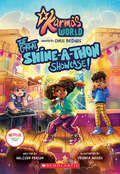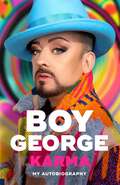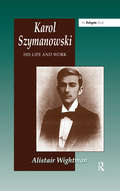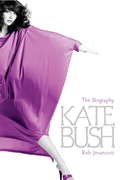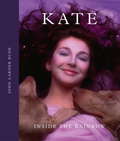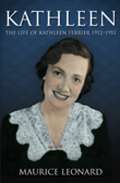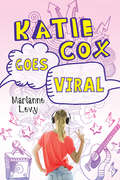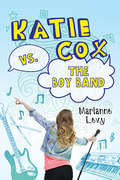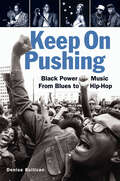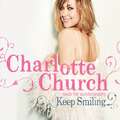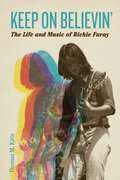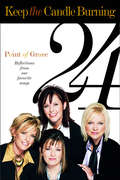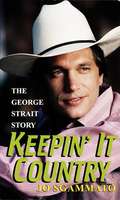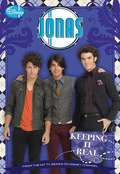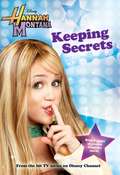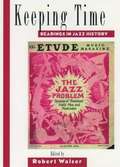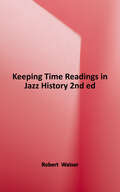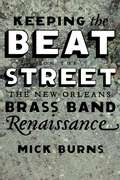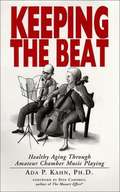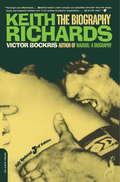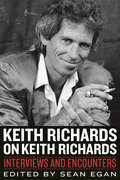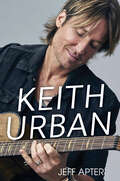- Table View
- List View
Karma's World: The Great Shine-a-Thon Showcase
by Halcyon PersonThis brand-new chapter book series follows aspiring rapper and hip-hop artist Karma from the Netflix animated series Karma's World!Meet Karma Grant! Karma and her friends are totally stoked for the MC Grillz concert in their neighborhood, Hansberry Heights! But when the famous rapper's bus breaks down and the show is canceled, it's up to Karma to make the best of some bad luck. Will Karma be able to put on her own concert, the Shine-a-Thon, with her friends or will the pressure prove to be way too much? Filled with heart, humor and Karma's own rhymes, this original chapter book is sure to delight any fans of the show!
Karma: My Autobiography
by Boy GeorgeThe Official Story of a Musical Icon─Told in Full for the First Time in his Own Words!"The most entertaining music memoir since Elton John's Me... This is George O'Dowd in all his exhausting glory." Observer#1 New Release in Gay Studies and LGBTQ+ BiographiesKarma is the definitive autobiography from the incomparable Grammy, Brit, and Ivor Novello award-winning lead singer of Culture Club, and LGBTQ+ vanguard: Boy George. Nothing short of an amazing story. Karma is the long-anticipated celebrity memoir from Boy George. The memoir delivers a searingly honest and captivating account of his extraordinary life. Take a front-row seat to the highs and lows of a life lived in the spotlight. Boy George's compelling storytelling shines a light on his encounters with legendary figures like David Bowie, Prince, and Madonna, providing an intimate peek into the music industry's glittering world.Humor, sarcasm, and signature style. This is the explosive and honest account of Boy George's life as a child growing up in sixties London and coming out to his Irish Catholic family. Hear his account of his exploration of his sexuality through the hedonism of the seventies (the glam rock and punk rock revolution that birthed Culture Club), his recollections of the heydays of the nineties, and his ultimately embracing the man and artist that he is today. For those seeking books on self-acceptance and recovery from addiction, Karma stands as an example of the transformative power of embracing one's true self.Inside explore:An explosive self-acceptance journeyThe glitz and glamour as well as personal struggles that have shaped Boy George's lifeAn essential addition to the library of celebrity autobiographies and LGBTQ+ books for adultsIf you enjoy lgbtq+ celebrity autobiography books such as Pageboy, Unprotected, or Starving In Search of Me, then Boy George’s Karma is for you.
Karol Szymanowski: His Life and Work
by Alistair WightmanThe music of the Polish composer Karol Szymanowski (1882-1937) has enjoyed a resurgence of interest in recent years. Despite wide recognition in his own lifetime, Szymanowski‘s works were somewhat overlooked in the decades following his death. Outside Poland, changing fashions militated against acceptance of his achievement, and subsequent generations of Polish composers regarded his music as too reactionary to provide a basis on which to found a national musical identity. In this full-scale study of Karol Szymanowski‘s life and music, Alistair Wightman explores the composer‘s position as a constant outsider in his own country, yet agood European in the ways in which he responded positively to a diverse range of musical talents, in particular as Stravinsky, Strauss, Berg, Hindemith, Prokofiev and Ravel. The book throws light on Szymanowski‘s relationship to the Polish musical establishment, the reception of his works at home and abroad, his work as an educationalist, and the essentially European dimension of his art, drawing on letters, polemical writings, verse, theatrical sketches and the memoirs of family, friends and contemporaries. All of Szymanowski‘s significant works are discussed, illustrated with nearly 140 music examples. Evaluation is made of the close links existing between the composer‘s musical and literary works from the earliest stages of his career, as well as the various ideological strands that went together to form the unique, humanistic synthesis, characteristic of his mature work.
Kate Bush: The biography
by Rob JovanovicKate Bush has written some of the most memorable songs in pop music history. Wuthering Heights, her debut single shot to number 1 in 1978 and she remains something of an enigma over a quarter of a century later. A singer, songwriter, musician, dancer, actress and director, Kate has inspired a devoted following around the world. Rob Jovanovic traces the story of Kate Bush's career, from her up-bringing in the Essex countryside through her first forays into music with a series of home recordings, to her number 1 debut album that propelled her to international stardom. Including exclusive interviews with studio musicians and choreographers, Jovanovic's biography emphasises both her voracious talent and her intensely private personality.
Kate Bush: The biography
by Rob JovanovicKate Bush has written some of the most memorable songs in pop music history. Wuthering Heights, her debut single shot to number 1 in 1978 and she remains something of an enigma over a quarter of a century later. A singer, songwriter, musician, dancer, actress and director, Kate has inspired a devoted following around the world. Rob Jovanovic traces the story of Kate Bush's career, from her up-bringing in the Essex countryside through her first forays into music with a series of home recordings, to her number 1 debut album that propelled her to international stardom. Including exclusive interviews with studio musicians and choreographers, Jovanovic's biography emphasises both her voracious talent and her intensely private personality.
Kate: Inside the Rainbow
by John Carder BushKATE is a collection of beautiful images from throughout Kate Bush's career. It includes outtakes from classic album shoots and never-before-seen photographs from The Dreaming and Hounds of Love sessions, and rare candid studio shots and behind-the-scenes stills from video sets, including 'Army Dreamers' and 'Running Up that Hill'. These stunning images will be accompanied by two new essays by John Carder Bush: From Cathy to Kate, describing in vibrant detail their shared childhood and the early, whirlwind days of Kate's career, and Chasing the Shot, which vividly evokes John's experience of photographing his sister. John Carder Bush: For me, each of these images forms part of a golden thread that shoots through the visual tapestry of Kate's remarkable career. Storytelling has always been the heartbeat of Kate's body of work, and it has been a privilege to capture these photographic illustrations that accompany those magical tales
Kate: Inside the Rainbow
by John Carder BushA MUST-HAVE COLLECTION OF RARE AND UNSEEN PHOTOGRAPHS OF KATE BUSH.WITH ESSAYS BY HER BROTHER, JOHN CARDER BUSH, ABOUT KATE'S LIFE AND CAREER.Stunning and unique images from throughout Kate Bush's career including:Outtakes from classic album shoots and never-before-seen photographs from The Dreaming and Hounds of Love sessionsRare candid studio shots and behind-the-scenes stills from video sets, including 'Army Dreamers' and 'Running Up that Hill'Includes original essays from Kate's brother: From Cathy to Kate: Describes in vibrant detail their shared childhood and the whirlwind days of Kate's career Chasing the Shot: A vivid evocation of John's experience of photographing his sister 'For me, each of these images forms part of a golden thread that shoots through the visual tapestry of Kate's remarkable career. Storytelling has always been the heartbeat of Kate's body of work, and it has been a privilege to capture these photographic illustrations that accompany those magical tales' John Carder Bush
Kathleen: The Life of Kathleen Ferrier 1912-1953
by Maurice LeonardKathleen Ferrier has a reputation as the greatest lyric contralto of the twentiety century. Her story, from her humble beginnings as a telephone operator in Blackburn to the height of international fame as one of the world's leading concert artists and her untimely death at the age of forty-one, is told told with compelling insight and perception, using a variety of sources, from photographs, diaries, and private letters to the memoirs and recollections of those who knew her best. Despite having no formal musical training, Kathleen worked with all the celebrated conductors of the time, and is remembered for her performances of music by Brahms, Schubert and Mahler, as well as a handful of operatic roles. Enlarging considerably on many alternative biographies, this excellent account captures the warmth, humour and charm of a figure whose astonishing life and career proved to be, sadly, all too brief.
Katie Cox Goes Viral
by Marianne LevyEverybody's watching Katie Cox...Katie Cox is used to going unnoticed, by her mom, her dad, even her best friend. But when a video of her singing in her bedroom goes viral, she becomes a superstar overnight. As the views skyrocket and a recording contract beckons, the real world starts to feel very far away.It isn't long before Katie starts riding high on her newfound fame. But the higher she goes, the further there is to fall...
Katie Cox vs. the Boy Band
by Marianne LevyKatie is going to have to face the music...Katie Cox (overnight singing sensation and owner of the World's Worst Bangs) never meant to become a pop star. And she didn't mean to start a war with Karamel (aka the World's Cheesiest Boy Band). Now her first concert is just days away. Cool? Maybe. Terrifying? Definitely. And with her school friends more interested in her fame than her feelings, and an army of Karamel fans ready to take her down, this battle goes way beyond the charts.
Keep On Pushing: Black Power Music from Blues to Hip-hop
by Denise SullivanAuthor Denise Sullivan explores the bond between music and social change and traces the evolution of protest music over the past five decades. The marriage of music and social change didn't originate with the civil rights and black power movements of the 1950s and 1960s, but never before had the relationship between the two been so dynamic. Black music altered the road to liberation for minorities, sparking creativity and resulting in a genre-encompassing poetry, jazz, folk, and rock along with a new brand of prideful and political soul and funk. Through extensive research and exclusive interviews with musician-activists such as Yoko Ono, Richie Havens, Janis Ian, and Buffy Sainte-Marie, this chronicle details the struggle that went into the creation of liberation music. A bittersweet narrative covering more than 50 years of fighting oppression through song, Keep On Pushing defines the soundtrack to revolution and the price paid to create it.
Keep Smiling
by Charlotte ChurchCharlotte Church burst onto the music scene when she was only 12 years old. She went straight to the top of the charts with VOICE OF AN ANGEL and sang for the Pope, the US President and royalty across the world. She has released five classical albums, one pop album, hosted her own TV Chat show and received numerous accolades, yet we are still continually fascinated by this Welsh star.Candid to the last, in her autobiography Charlotte reveals herself as never before. She talks of her life, career, family and loves and motherhood with surprising intimacy and, being true to her outspoken reputation, complete honesty. Keeping her feet firmly on the ground, Charlotte Church is a genuine superstar of our times. She combines being a style icon and international diva with being a true family person who always makes sure she has supper with her nan every Tuesday night.Read by Charlotte Church(p) 2007 Orion Publishing Group
Keep on Believin’: The Life and Music of Richie Furay (American Music History)
by Thomas M. KittsOne of America’s great rock and roll pioneers, Richie Furay played alongside Neil Young and Stephen Stills in Buffalo Springfield, producing some of the signature sounds of American folk rock. He went on to form Poco, one of the bands that founded California country rock, and then Souther-Hillman-Furay. After declaring himself a Christian in 1974, Furay released four solo albums before taking up the ministry in 1983. He began recording again in 1997, and over the next twenty-five years he released two Christian and five secular albums.In this biography of Rock & Roll Hall of Famer Richie Furay, Thomas Kitts provides an intimate look at Furay’s life and music. Kitts chronicles the musician’s upbringing, his musical career, and his Christianity, drawing on interviews with Furay and others close to him. In documenting Furay’s extraordinary talent as a songwriter, vocalist, and guitarist, Kitts argues that although he never attained the level of stardom of many of his bandmates, Furay is a pivotal figure in American popular music.Fans of Buffalo Springfield, Poco, and country-rock music will enjoy this quintessentially American story of a young man on a quest to fulfill his rock-and-roll dreams.
Keep on Singing: A Ballad of Marian Anderson
by Myra Cohn Livingston"When she sang Deep River, One teacher wondered why A tall, calm girl at twilight Should make him want to cry." (The teacher was Arturo Toscanini.) Other books by this American poet are available in this library.
Keep the Candle Burning: 24 Reflections from Our Favorite Songs
by Point Of GraceKick back, put your feet up, and settle in for an intimate conversation with the four young women of Point of Grace. In this delightful book of two dozen insightful reflections, the four artists of this award-winning musical group offer a rare glimpse into their lives as performers, wives, mothers, and friends -- and, most of all, give you a fresh perspective on Scripture and the wonder-working God they serve through their music. In each of the book's twenty-four chapters -- one for each featured #1 song -- a member of the group takes a turn sharing a story about the hits that have been especially meaningful to her. Keep the Candle Burning will encourage and inspire you as you read about the triumphs, struggles, and hopes of Shelley, Terry, Heather, and Denise -- the women of Point of Grace. Book jacket.
Keepin' It Country: The George Strait Story
by Jo Sgammato[From the Back Cover:] "A Superstar's journey into America's heart George strait has garnered thirty-one #1 hit singles and twenty-two gold, platinum, or multiplatinum albums, making him one of the top ten biggest--selling musicians working today. It's no wonder. The handsome Texan with the rich, smooth voice stays true to the music he and his millions of fans love best--traditional and contemporary country. Keepin' It Country explores what America loves so much about George strait: the tremendous talent he generously shares while keeping his own life private, his authentic country life and spirit, and his renown as a true gentleman whose career is the bridge between the past and the future of country music. From his first hit album, Strait country, to his starring role in the hit film pure country to his reign at the top of the charts for an unprecedented sixteen years, here is a triumphant tribute to the man and the music. Ladies and gentlemen, Mr. George Strait..."
Keeping It Real (Jonas Brothers)
by Lara BergenRetelling two episodes of the Disney Channel's newest live-action comedy series, this junior novel is about three brothers--Kevin, Joe, and Nick Lucas--who perform under the name JONAS.
Keeping Secrets (Disney's Hannah Montana #1)
by Beth BeechwoodHannah Montana might seem like a regular girl next door But she's got a big secret. When the lights go down. Miley is the pop star Hannah Montana! But keeping that secret--and balancing school and homework with her newfound fame and fortune--is harder than Miley ever thought it would be. And when her friend Oliver becomes totally obsessed with Hannah Montana, Miley doesn't know what to do. How can she possibly keep her super star identity hidden with Oliver constantly in her face in her limo, everywhere?!
Keeping Time: Readings in Jazz History
by Robert WalserDrawing from contemporary journalism, reviews, program notes, memoirs, interviews, and other sources, Keeping Time lets you experience, first hand, the controversies and critical issues that have accompanied jazz from its very birth. Edited by Robert Walser, these sixty-two thought provoking pieces offer a wealth of insight into jazz.
Keeping Time: Readings in Jazz History
by Robert WalserFeaturing over 70 thought-provoking selections drawn from contemporary journalism, reviews, program notes, memoirs, interviews, and other sources, Keeping Time: Readings in Jazz History, Second Edition, brings to life the controversies and critical issues that have accompanied over 100 years of jazz history. This unique volume gives voice to a wide range of perspectives that stress different reactions to and uses of jazz, both within and across communities, enabling readers to see that jazz is not just about names, dates, and chords, but rather about issues and ideas, cultural activities, and experiences that have affected people deeply in a great variety of ways. <p><p>Selections include contributions from well-known figures such as Jelly Roll Morton, Billie Holiday, Charles Mingus, Louis Armstrong, Dizzy Gillespie, and Miles Davis; from renowned writers including Langston Hughes, Norman Mailer, and Ralph Ellison; and from critics and historians ranging from Gunther Schuller and Christopher Small to Sherrie Tucker and George Lipsitz. This second edition features thirteen new selections concentrating on recent jazz scenes and updated headnotes throughout, which provide historical context for each selection and point out issues for thinking and discussion. Filled with insightful writing, Keeping Time aims to increase historical awareness, provoke critical thinking, and encourage lively classroom discussion as students relive the intriguing story of jazz.
Keeping the Beat on the Street: The New Orleans Brass Band Renaissance
by Mick BurnsTold in the words of the musicians themselves, Keeping the Beat on the Street celebrates the renewed passion and pageantry among black brass bands in New Orleans. Mick Burns introduces the people who play the music and shares their insights, showing why New Orleans is the place where jazz continues to grow. Brass bands waned during the civil rights era but revived around 1970 and then flourished in the 1980s when the music became cool with the younger generation. In the only book to cover this revival, Burns interviews members from a variety of bands, including the Fairview Baptist Church Brass Band, the Dirty Dozen, Tuba Fats' Chosen Few, and the Rebirth Brass Band. He captures their thoughts about the music, their careers, audiences, influences from rap and hip-hop, the resurgence of New Orleans social and pleasure clubs and second lines, traditional versus funk style, recording deals, and touring. For anyone who loves jazz and the city where it was born, Keeping the Beat on the Street is a book to savor. "We should be grateful to Mick Burns for undertaking the task of producing... the only book to cover the subject of what he rightly calls the brass band renaissance." -- New Orleans Music"A welcome look at the history of brass bands. These oral histories provide a valuable contribution to New Orleans musical history.... What shines through the musicians' words is love of craft, love of culture." -- New Orleans Times-Picayune "A seminal work about the Brass Bands of New Orleans." -- Louisiana Libraries
Keeping the Beat: Healthy Aging Through Amateur Chamber Music Playing
by Ada P. KahnDust off your clarinet! You can express yourself and improve your health through music. Ada Kahn's Keeping the Beat encourages older amateur musicians who play violins, cellos, flutes, and recorders to make joyful sounds with others.
Keith Richards
by Victor BockrisIn 1992, Victor Bockris's celebrated biography was the first to recognize Richards's pivotal role in the Stones' legend. Now that book on rock's most incredible survivor has been expanded to accommodate ten more years of his storied life.
Keith Richards on Keith Richards: Interviews and Encounters
by Sean EganThe iconic life and career of the famed guitarist of the Rolling Stones is detailed in this compilation of interviews that spans the last 50 years. Featuring articles from GQ, Melody Maker, and Rolling Stone, as well as interviews that have never previously appeared in print, it charts Keith Richards's journey from gauche, young pretender and swaggering epitome of the zeitgeist to beloved elder statesman of rock. Initially overshadowed by band mates Mick Jagger and Brian Jones, Richards gained popularity as half of the second-most important songwriting team of the 1960s, and in 1967 the drug bust at his house and his subsequent trial and imprisonment made him a household name. His interviews match his outlaw image: free of banality and euphemism, they revel in frank stories of drugs and debauchery. Yet they also reveal an unexpectedly warm, unpretentious, articulate, and honest man. This collection amply illustrates the magic and charm of Keith Richards.
Keith Urban
by Jeff ApterIn this definitive biography of Keith Urban, music biographer Jeff Apter presents the legendary Australian country star turned international superstar whose career spans the Nashville music scene, American Idol, The Voice, and much more, including the highs and lows along the way. Keith Urban came from humble origins. His father worked at the local landfill and Keith was a high school dropout. But Keith had a plan: conquer Nashville. &“It&’s my destiny,&” he said. And Keith was hell-bent on scaling that musical Everest. Whatever it took. It didn&’t come easy. Keith served his apprenticeship in the beer barns of Australia, and his early trips to America were disastrous. But he never gave up, settling in Nashville in the 1990s and forming The Ranch. When the band fell apart, so did Keith, ending up in rehab (not for the last time). But Keith did eventually reach the top, through a combination of talent, charisma, sex appeal, dogged perseverance—and skin thick enough for a rhino. And along the way he married Nicole Kidman. As Keith has said, &“All those detours, the really dark ones, got me to where I am now. I would not want to change one leaf on any tree in the whole journey.&” Keith Urban is the definitive biography of an international superstar.
